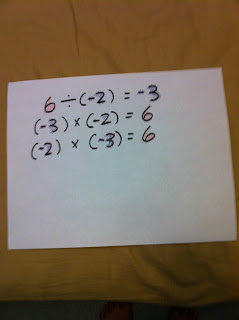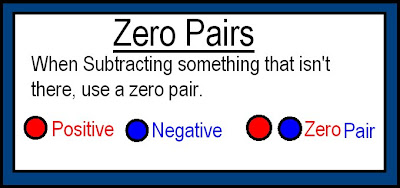Grade 7 Integer Review
Integers can be represented with a number lines or integer chips.
integers are usualy represented with two colors red and blueNegative - Blue
Positive - Red
Zero Pairs - a pair of negative and positive numbers and the sum is zero.
ex. (-3) + (+3) = 0.
This is a rhyme you should sing to yourself during a test if you can't remember when to use a zero pair.
When subtracting something that isnt there, use a zero pair.
In grade 7 we did integers like this
(-3)+(+7)= the thing about doing integer in grade 7 is there is brackets.
Here are some questions:
13. a)(+4)x(+6)=24
d)( -8)x(-2)=16
Chapter 2
multiplying integers
Here are some questions we did.
10. a(17)x(-24)= -408
b(34)x(22)=56
For a multyplycation question that needs a zero pair you can see how many zero pairs you need by multiplying the two factors in the question without their negative or positive signs.
ex. (-2) x (+3) - 2 x 3 = 6
1.6÷2=3
6 groups of 2
2. 3÷2=1.5
3 groups of 2
If you know the number that is in each group, but you dont know the number of groups then that is quotative division.
1.(-6)÷(2)= -3
another way to mutiply intgers is multiplicated-inverse
-2÷-3
-3÷-2
-In a division question with an even amount or no (-) signs the quotient will be positive.
-In a divison question with an odd amount of negative signs the quotient will be negative
Chapter 4
Order of operation with integers
(+5) x (-3) + (-6) / (+3) =
To do order of opration u won't to follow the rules of B.E.D.M.A.S. Brackets, Exponents( except there are no exponents in bedmas) , Division, Multiplication, Addition, Subtraction.
First add square brackets around the expressions with a x or / to help remind you to answer them first. The square brackets means that you should answer the question in them before doing anything else.
1.-6-9+10-1= -6





 For questions needing a zero pair you can
For questions needing a zero pair you can 

 In a
In a 














































